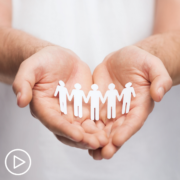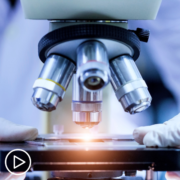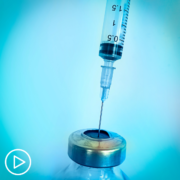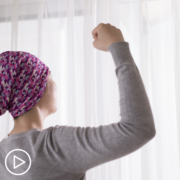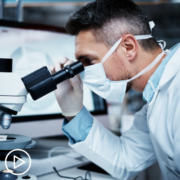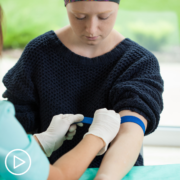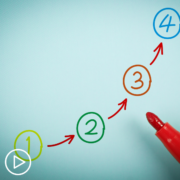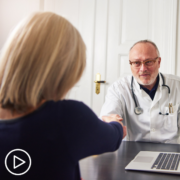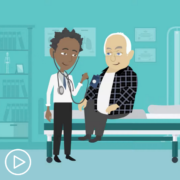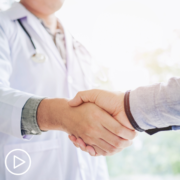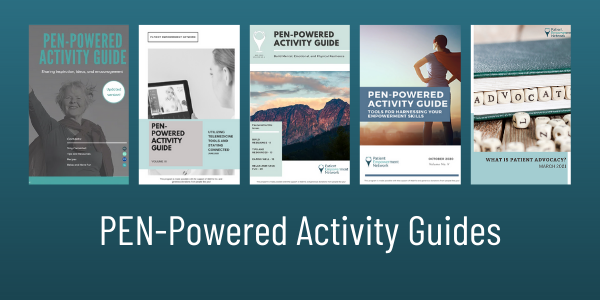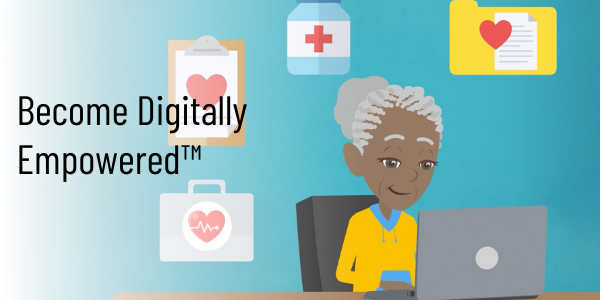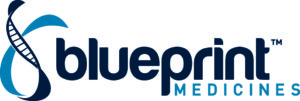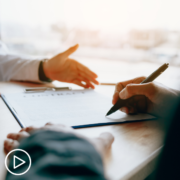How to Play an Active Role in Your CLL Treatment Decisions from Patient Empowerment Network on Vimeo.
How can you partner with your healthcare team to feel confident in your CLL decisions? In this webinar replay, Dr. Matthew Davids discusses CLL treatment approaches, developing research and tools for partnering with your healthcare team. Dr. Matthew Davids is the Director of Clinical Research in the Division of Lymphoma at Dana-Farber Cancer Institute.
Download Guide
See More from Engage CLL
Related Resources:
Transcript:
Katherine:
Hello and welcome. I’m Katherine Banwell, your host for today’s program. Today we’re going to explore the factors that guide CLL treatment decisions, including your role in making those decisions. Before we meet our guest, let’s review a few important details. The reminder email you received about this program contains a link to program materials. If you haven’t already, click that link to access information to follow along during the webinar. And at the end of this program, you will receive a link to a program survey. This will allow you to provide feedback about your experience today, and it will help us plan future webinars.
Finally, before we get into the discussion, please remember that this is not a substitute for seeking medical advice. Refer to your own healthcare team. All right, let’s meet our guest today. Joining me is Dr. Matthew Davids. Dr. Davids, would you please introduce yourself?
Dr. Davids:
Hi, Katherine. Thanks so much for having me. It’s great to be with everyone today. I’m Matt Davids. I’m a CLL-focused physician based at Dana Farber Cancer Institute in Boston, and I’m also an associate professor of medicine at Harvard Medical School. And I get to wear many hats here. First and foremost, I take care of patients, particularly patients with CLL, but I also have some administrative roles. I direct our clinical research program in the lymphoma division. I also run a research laboratory focused on CLL and other lymphoid cancers, and I run about a dozen clinical trials mostly focused on developing new treatment options for patients with CLL.
Katherine:
Wow. Sounds like you’re a busy guy. I’m glad you have the time to join us today.
Dr. Davids:
My pleasure.
Katherine:
Let’s start with a question that’s on the mind of many of our audience members. Is the COVID-19 vaccine safe for CLL patients?
Dr. Davids:
Very timely question. The simple answer is yes. There are now actually three different vaccines that have been granted emergency use authorization by the FDA.
And I would say that so far, we’ve seen clinical trial evidence suggesting these are very safe vaccines in the general population.
Our own experience with our own CLL patients so far has also suggested safety, so I think it’s very important that our CLL patients get vaccinated as soon as they can. I think the bigger concern more than safety is on the efficacy side of the vaccine, meaning how effective are these vaccines going to be for CLL patients? That’s not something that we know yet from the larger clinical trials that have been done. So, those numbers you see quoted, 95 percent protective, that’s in the general populations.
We do worry a bit based on our experience with other vaccines in CLL patients that they may not be quite as effective, but we don’t know that yet. Fortunately, that’s something that we’re studying now, both at our center and in some nationwide efforts, to look for example at the antibody production that CLL patients can make before and after vaccination. I’m hopeful that over the next few months we’ll start to learn about how effective these vaccines are specifically for CLL patients.
We certainly expect they will have some benefit, so that’s why we recommend vaccination for all of our CLL patients. But once patients are vaccinated, it doesn’t give them a free pass to then take their masks off and go back to normal life. Particularly CLL patients I think need to be careful even after vaccination to continue to do social distancing, hand hygiene, and all these things.
Katherine:
Is there one type of vaccine that’s more suited for CLL patients?
Dr. Davids:
Nope. As far as we can tell, all three of the approved vaccines so far are safe and should have some good effects for CLL patients.
There’s no benefit of one versus the others, so the best one to get is the one that’s in your muscle and injected. Whatever you can get access to, that’s the best one for you.
Katherine:
Dr. Davids, have there been any recent developments in CLL treatment and research that patients should know about?
Dr. Davids:
Yeah. We could spend a few hours on this, but I’ll try to summarize it. There’s a lot of exciting developments in the field. and I think we’re going to get into some of the specific treatments in a few minutes, but I would say at a high level obviously, over the last decade the entire field of CLL treatment has been transformed. Whereas we only had chemotherapy-based approaches before, now we have a whole number of different drugs that we call novel agents. And the reason why they’re novel is that they target the CLL cells, but they spare the other cells in the body, so there’s less collateral damage there. What that means is that they have fewer side effects, and they’re more effective, so it’s really a win-win situation for patients.
There’s kind of been two main approaches for this.
One is to start a novel agent drug and to continue it for as long as it’s helping, which fortunately for most patients is a long time, many years. And then, a newer approach is actually to do what’s called time-limited therapy where you start usually at least a couple of these different novel drugs together but hopefully achieve what we call a very deep remission, meaning excellent shrinkage of lymph nodes and improvement of blood counts and bone marrow disease. And by getting these very deep remissions the idea is we can do a finite period of treatment, whether it’s one year or two years, it kind of depends on the regimen. And then, stop therapy and hope that patients can then enjoy many years of remission while off therapy, which can be nice in terms of reducing side effects and costs and all these other things.
So, those are the biggest developments in the field right now, the continuous novel agent therapy and time-limited novel agent therapy. And a lot of the clinical trials that are getting off the ground now are starting to compare these two strategies to figure out really what’s the optimal way to treat CLL patients.
Katherine:
How can patients stay up-do-date on developments like these?
Dr. Davids:
It’s definitely challenging. It’s challenging even for us who are in the field to keep up with things on the academic side. I think for patients, seeking out patient-friendly sources of information on the web are helpful, but sometimes it can be hard to know what’s reliable information on the web. So websites like this and programs like this I think can be very helpful. Another resource that a lot of my patients find helpful is the CLL Society, so www.cllsociety.org. Brian Koffman really curates a lot of the new developments in the field on that website nicely. He interviews a lot of different CLL experts in this short format that can be very digestible for patients. Patient Power is another great website. So, there are a bunch of them out there, and I think those can be a great resource for our patients.
Katherine:
When a person is diagnosed with CLL they have a whole healthcare team. Who’s typically on that team?
Dr. Davids:
It’s definitely a multidisciplinary team.
Usually there’s an oncologist-hematologist who’s leading the team as a physician, but there’s a very large team of other people who are involved, whether it’s an advanced practice person such as a nurse practitioner or a physician’s assistant. They’re often very closely involved with the day-to-day patient care. There’s nurse navigators in some places that can help with getting access to these novel agents and with looking into clinical trial opportunities. There’s pharmacy folks who are very helpful sometimes in checking in on side effects, and advising on dosing, and so forth.
That’s more on the provider side of things. But, of course, the care team really includes the caregivers for the patient, whether it’s family members or friends, who are really a crucial part of this. The field is very complicated, and one of the challenges with COVID recently is that I’ve always invited family members and friends to come to visits with patients, because I do think it’s helpful to have many people listening. And that’s been hard because we’ve had to restrict visitors usually to either no visitors or one visitor because of COVID precautions.
Even if that’s the case, you can still have people dial in by phone or use technologies like FaceTime to try to have them there with you, because I think having that extra set of ears can be helpful as you hear all this information coming at you from your oncologist.
Katherine:
Yeah, absolutely. So, it really does sound like it’s a whole team approach. We have a question from the audience. Linda writes, “I’ve heard that CLL doesn’t need to be treated right away. Is that true?”
Dr. Davids:
That is true for the majority of CLL patients, and it’s actually a very counterintuitive thing. We’re conditioned that if you have cancer that it’s important to be proactive and get rid of it as quickly as possible, the sooner the better, and that is actually not the case in CLL. And we didn’t just take a guess that that’s the best approach. This is actually something that’s been studied in clinical trials. There were several clinical trials launched in the ‘70s and ‘80s looking at an early intervention strategy using a chemotherapy-based approach to see if treating at the time of diagnosis would be better than waiting until patients developed more significant symptoms.
And all of those studies did not show a benefit to early intervention.
Now, more recently those studies have been challenged as somewhat out of date, which is a fair criticism because they used an older chemotherapy drug. And so, there is a newer study now going on in Europe that is looking at early intervention with the drug ibrutinib, which is one of our novel agents for CLL, looking to see if early intervention with ibrutinib, particularly for patients who have a higher risk form of CLL, may be beneficial.
But we have seen some data now already presented from this study that do not show any improvement in how long the patients live by treating with ibrutinib early, and we do see some of the typical side effects that we’re accustomed to seeing with ibrutinib. So, even with the newer data that we’re seeing, we still do not recommend early intervention for patients with CLL.
Katherine:
I’ve heard this term “watch and wait.” What does that mean?
Dr. Davids:
Yeah, it’s not the best term because it’s very passive. That refers to this observation strategy. I like to think of it more as “active surveillance.” It seems more proactive because you’re doing something about it.
You’re really checking the blood counts, you’re getting your physical exam, you’re checking in on symptoms, these sorts of things, and really keeping a close eye on the disease. And that’s the approach that we like to take with our patients to really keep them engaged, making sure they’re staying up-to-date on their screenings for other cancers, making sure they’re getting vaccinations, these sorts of things are all the things we do with active surveillance.
Katherine:
How is someone monitored during this watch-and-wait period?
Dr. Davids:
It varies depending on individual patients. We’ve alluded to the fact that there’s different genetic subgroups of CLL already, so there are some patients that have higher-risk disease. The example of that usually is deletion 17p that people may have heard of on the FISH test. For those patients I usually am seeing them every three months or so, physical exam, checking on their history, checking their bloodwork. But there’s quite a few CLL patients who have lower-risk disease. If they have for example mutated IGHV, if they do not have the 17p for example, those patients may be able to be seen once every six months or so with a similar setup.
I don’t routinely get CAT scans on a regular basis for most patients. Most patients don’t need bone marrow biopsy tests unless they’re starting treatment. So, it’s mostly it’s exam, talking to patients, and checking the bloodwork.
Katherine:
Okay. So, how does CLL progress? When do you know when it’s time to treat?
Dr. Davids:
The stages of CLL involve the progression of the disease. When we first meet patients, often they only have cells circulating in the blood, and that’s called stage 0 disease. It’s one of the few cancers where there’s actually a Stage 0 before even Stage I, and the reason for that is that many patients can go for years on Stage 0 disease. But as the burden of the CLL cells begin to accumulate in the body they can start to collect in their lymph nodes, and the lymph nodes can start to swell up whether it’s in the neck or the armpits or elsewhere. That’s stage I disease.
They can accumulate in the spleen, which is an organ in the abdomen. It’s kind of a big filter for your bloodstream, and as the filter traps more of these lymphocytes the spleen can slowly enlarge over time. That’s stage II disease.
And then finally, the CLL cells can get into the bone marrow, which is like the factory for making your blood cells. And if the factory floor gets all gummed up with CLL cells it can’t make the normal red cells, that’s called anemia. Or it can’t make the normal platelet cells, that’s called thrombocytopenia. And when we start to see those more advanced stages III and IV of CLL, that usually does require treatment. And what the treatment does is it clears out the factory floor and it allows for the normal machinery to make the normal blood cells again. So, that’s one of the more common reasons why treatment is needed is due to anemia and low platelets. Second reason can be if the lymph nodes or spleen get so bulky that they’re uncomfortable or threatening organs internally. We want to treat before that becomes a real threat.
And then, the third thing that usually happens as the disease progresses, patients can develop some symptoms, what we call constitutional symptoms. These can be things like unintentional weight loss, drenching night sweats that are happening on a consistent basis, and those sorts of things. So, if that’s happening at the same time as these other factors are progressing, those would be reasons to treat.
And notice that one thing I did not say is the white blood cell count itself.
That’s a common misconception. Some people think that as the white blood cell count goes higher – and people use all different thresholds, 100, 200 – that by crossing that threshold you need to start treatment. And in fact, that’s not the case. We have many patients whose white blood cell count can get very high but then it can kind of level off and plateau for a period of several years, and as long as they don’t meet those other treatment indications, they don’t need to be treated just based on the white count alone.
Katherine:
Hmm, okay. Well, once it’s time to treat, of course then it’s time to think about treatment options. Let’s walk through the types of treatments that are used today to treat CLL.
Dr. Davids:
As I alluded to before, we historically have had chemotherapy-based approaches to treat CLL. And that was an effective way to temporarily put the disease into remission, but it had a lot of side effects and inevitably the CLL would come back. And the challenge particularly with chemotherapy-based approaches it that when the CLL does come back after chemotherapy, it tends to behave more aggressively and be harder to treat.
So, there have been quite a few studies over the last few years trying to figure out ways that we can avoid using chemotherapy as the first treatment, and this can involve treatments such as monoclonal antibodies. People may have heard of rituximab or a newer drug, obinutuzumab. There are the inhibitors of the B-cell receptor pathway, and this is for example ibrutinib, which targets a protein called BTK, also a newer one called acalabrutinib, which targets BTK. And then, I mentioned at the beginning these fixed-duration therapies that stop after a period of time. Many of those are based on a newer oral drug called venetoclax, which when we give it as a first therapy, we give in combination with that antibody obinutuzumab.
So, a bit of an alphabet soup. I know it gets confusing with all the different treatments, but the good news for CLL patients is, 1.) we have a lot of options, which is great, 2.) we don’t necessarily need to use chemotherapy anymore, and in fact I use it pretty rarely these days. One situation where I do still consider chemotherapy is for younger patients – which in the CLL world is sort of under age 60 or so – if they have very favorable biology to the disease, in particular this mutated IGHV.
That’s a scenario where the older chemotherapy regimen, FCR, can be very effective. It’s a six-month treatment, and we have patients with those molecular characteristics who are now 12, almost 15 years out from their initial six months, and they’re still in a complete remission. So, many of those patients have been functionally cured of their CLL from the six months of treatment. But again, there are some risks to that approach. We worry about other cancers that may be more likely after receiving FCR. We worry about infections, and particularly in the COVID situation, we worry about COVID infection in patients on chemotherapy.
So, it’s been pretty rare that I’ve been using that approach these days. I’ve been opting more for the novel agent-based approaches. So, often now the conversation as an initial therapy comes down to, “Do you prefer more of a continuous treatment strategy with a BTK inhibitor drug like ibrutinib or acalabrutinib, or do you like the idea of a time-limited therapy with one year of venetoclax in combination with obinutuzumab?” And I would say there’s pros and cons to both approaches, and we don’t know which one is the optimal one for CLL patients to start with, but probably I think most patients at some point in their lifetime are going to need one therapy or the other.
So, maybe in the end it doesn’t matter too much which one you start with if you’re going to get both eventually anyway. But we don’t know that yet.
Katherine:
Right. Where do clinical trials fit in with the treatment approaches?
Dr. Davids:
So, clinical trials are really how we’ve made all these advances in CLL over the last decade. It’s how we learn about new treatments. It’s how we learn about how to optimize the treatments that we have. I think sometimes patients have a misconception that clinical trials are a last resort, the idea that you’ve exhausted all the standard options and then you go to a clinical trial as your last hope. But I actually like to kind of turn that on its head and say that clinical trials are actually the first resort, the first best option for patients. Whenever patients can get access to a clinical trial at any stage of their disease, I would really encourage them to consider it.
We have quite a few clinical trials now in the frontline setting, meaning as an initial treatment for CLL, including some that are in development and will open soon. And these are the studies that are going to really help us define what the optimal regimens are. What’s the optimal sequence of these different novel agents?
And in CLL, really, we’re at a point where the research on the disease is so mature that when you’re in a clinical trial you’re either going to be on one regimen that you know you’re getting and you know it’s going to be an effective regimen, or you might be in a comparative trial where you could be randomized to one of two or three different regiments, but you know that each one of those regimens is one that we think is a great regimen. We just don’t know which one is optimal for individual patients. So, this is not a situation where there’s placebo-controlled trials where you don’t know if you’re going to get an active treatment or not. CLL is an area where we design our clinical trials so that all patients are going to be benefiting from cutting-edge approaches.
And so, not all patients have access to trials, and that’s okay. Again, we’re fortunate that we have many good options that can be given locally, but I do encourage patients even if they’re only able to travel to a CLL specialist once to have an initial consultation to think about doing that to get a CLL specialist on your team, so to speak. That way they can identify clinical trial options that may be a good fit, and even if not, they can advise on what the optimal treatment options are to receive locally with your own oncologist.
Katherine:
How do patients find out about these clinical trials?
Dr. Davids:
I do think the best way is through a CLL specialist because certainly they would have a great pulse on the trials, they have available at their own center. They should also have a sense for what trials are available maybe at other centers. Some of that can also be, there’s a great resource through The Leukemia & Lymphoma Society where they can help navigate patients toward specific trials that may be applicable to them.
There’s also a website called clinicaltrials.gov. It can be a little challenging if you’re not familiar with it to navigate the site, but it is actually pretty straightforward. You can put in the disease and look at different options for trials based on different drugs, for example. They’ll list the eligibility criteria for the trial. That’s often I find a way that patients can begin to identify whether they may be a candidate. You can’t tell from the website whether you’re definitely a candidate or not. You really need to partner with an investigator who’s on the trial to learn that, but it certainly can be a good starting point to figure out what’s out there.
Katherine:
With CLL, what are the goals of treatment?
Dr. Davids:
I like to say to patients, “The goals are to make you live longer and live better.” You want to obviously have treatments that prolong life, but you also want to have treatments that are helping with symptoms, and giving patients more energy, and making them feel better, and protecting them from some of the risks of the disease. And so, I think the goals do vary a bit based on the stage of life that patients are at.
I see a lot of patients in their 70s and 80s, and in those patient’s symptom control, having the disease be in a good remission, allowing them to live their life is a good goal. I sometimes see patients in their 40s and 50s, and some of those patients want to be a bit more aggressive and try to do a strategy that will get them a very long-term remission, and even potentially explore potentially curative strategies.
If I have a higher-risk patient with deletion 17p who’s young and fit, and they’ve already had some of the novel treatments, that’s where we start thinking about clinical trials of some of the cellular therapies like CAR-T cells that people may have heard of where you use the T cells from the patient to try to use that as a therapy to kill off the disease. Or even a bone marrow transplant is something that we have used historically in CLL. We don’t use it as often now, but for younger patients with high-risk disease it’s still a consideration to try to achieve a cure of the CLL even though the risks of that are significant.
It sounds like there are several factors to weigh then in making this decision. Lately we’ve been hearing the term “shared decision-making,” which basically means that patients and clinicians collaborate to make healthcare decisions.
And it can help patients take a more active role in their care. What are your thoughts, Dr. Davids, on how best to make this process work?
Dr. Davids:
Yeah, I fully support that model. I think for most patients it’s very helpful to be an important decision maker. Really the patient is the ultimate decision maker to say what they want for their own treatment. And sometimes it’s hard for me to predict what a patient will want for themselves, so I see my role for most patients as providing the information that they need to make the best decision possible for themselves.
I do try to steer patients a bit in the directions that I think they should be thinking. I’m not going to necessarily present a laundry list of things to patients. I’m going to try to narrow it down to what I think are the most reasonable choices for a patient to make.
I feel that’s part of my job. I do still have patients who just say, “Just tell me what to do,” and I respect that, too. Not all patients want to be part of shared decision making, and they just want me to decide, and that’s fine. But I do find that most patients like the idea of having a voice and being the one to decide, and that way I can help to guide them, but ultimately, it’s up to them.
Katherine:
Well, speaking of patients having a voice, are there questions that patients should consider asking when they’re thinking about a proposed treatment plan?
Dr. Davids:
Yeah. I think some of the key ones revolve around basic stuff, but sometimes it’s hard to think of it in the moment. But thinking about, what are the risks of this therapy? What are the specific side effects that are most common? When you look at a package insert or you look at a clinical trial consent form, you’re going to see 100 different side effects listed. I always promise patients, “You won’t have every single side effect that’s listed here, but you may have a couple of them.” And again, my role often is to identify which are the more common side effects that we see and how can those be managed?
And then, I think often you’re just asking simply about what are the potential benefits of this therapy? What are the odds that I’m going to get into remission? How long is this remission likely to last?
And then, something that is often challenging for patients to think about – it can be challenging for me as well – is to think about what’s the next step? So, I think a good question to ask is, “If I choose Therapy A, what happens if I need therapy again in a few years? What are the options at that point?” because we’ve been talking so far mostly about what we call frontline therapy, making that initial choice of treatment. But then, once you get into what we call the relapse setting, a lot of the decision of what to receive at that point depends on what you got as the first therapy. And so, trying to think at least one step ahead as to what the next options are I think can be helpful, certainly for the physicians but also for the patients.
Katherine:
Do you have any advice to help patients speak up when they’re feeling like their voice isn’t being heard?
Dr. Davids:
That’s always a challenging situation, but I encourage patients not to be shy about asking questions.
There’s often an imbalance in terms of the information where the oncologist may know more than the patient about a particular condition. And so, I think reading up and trying to educate yourself as much as you can. Whenever possible, including a family member or friend as part of the visit to also help advocate for you. And then, if you’re not being heard the way that you think you should be, thinking about seeking out another provider who may be able to listen more.
And sometimes that can be again helpful to have a touchpoint with a CLL specialist who may be able to reinforce some of what you’re thinking. If what you’re reading online or seeing online is different from what your oncologist is telling you, that may be a sign that it’s good to get a second opinion and just make sure you’re on the right track.
Katherine:
All really helpful advice, Dr. Davids. Before we end the program, what are your thoughts about the future of CLL treatment and research?
Dr. Davids:
I’m very optimistic about where things are right now. We’ve gotten to this point where we have so many different effective options, so it’s fun for us to now design this next wave of clinical trials to really try to optimize the outcomes for patients.
One area I’m particularly interested in is a concept called MRD, which we haven’t talked about yet, but minimal residual disease is a way to look even at a molecular level for tiny amounts of CLL that may be left behind after treatments. And so, one of the things I’m particularly excited about is the idea eventually of using what we call MRD-guided therapy.
So, we talked before about continuous treatment. We talked about what we call fixed-duration treatment where everyone gets a year or everyone gets two years. MRD-guided therapy would actually allow us to vary the length of therapy depending on how a particular patient responds. So, some patients may need one year of a particular combination, but other patients may need two years. This could be a way to really individualize therapy for particular patients. It’s also a way to monitor patients who are in remission after they’ve stopped therapy.
And so, there’s another wave of trials looking at, should we be intervening early when patients develop recurrence of their MRD rather than waiting until they’re having progression of the disease? There’s still a lot of unanswered questions about these sorts of approaches, but I think it’s going to help us get even better at treating CLL.
All of this is contingent though upon the fact that patients continue to be interested in clinical trials and enrolling in trials so that we can really push the boundaries and learn even more about the disease. So, again, if no other message comes through, it’s really to think about clinical trials as a way to continue to improve outcomes for all patients with CLL. I think it’s a great situation where both the individual patient who’s participating in the trial can stand to benefit, but then also you can really be giving back and helping others.
Katherine:
Dr. Davids, thank you so much for taking the time to join us today.
Dr. Davids:
It’s my pleasure. Thanks so much.
And thank you to all of our partners. If you would like to watch this webinar again, there will be a replay available soon. You’ll receive an email when it’s ready. You’ll receive an email when it’s ready. Don’t forget to take the survey immed – don’t forget to take the survey immediately following this webinar. It will help us as we plan programs for the future. To learn more about CLL and to access tools to help you become a proactive patient, visit powerfulpatients.org. I’m Katherine Banwell. Thanks for joining us.
